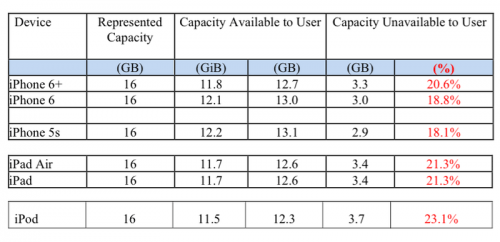iOS 8 was launched by the company Apple Lossless Audio CODEC (ALAC), in September of this year and generated big problems for users from the very beginning. Why am I saying this? Well, because just like its predecessor, it requires a few GB of free space in the terminals to be installed via OTA Update, and then takes up more space than iOS 7 after installation.
In the image above you have presented a table with the free storage space promised by Apple when buying an iDevice and the free space after installation iOS 8. 6 iPhone Plus has a version of iOS 8 that occupies 3.3 GB, it is followed by iPhone 6 with 3 GB and iPhone 5S with 2.9 GB, iPad tablets needing 3.4 GB, while an iPod Touch 3.7 GB, surprisingly requiring more files than all the others.
Apple's misrepresentations and omissions are deceptive and misleading because they omit material facts that an average consumer would consider in deciding whether to purchase its products. Rather ironically, Apple touts iOS 8 as 'The biggest iOS release ever.' Of course, Apple is not referring to the literal size of iOS 8, which appears to be entirely undisclosed in its voluminous marketing materials extolling the purported virtues of iOS 8.
Dissatisfied with the large space occupied by iOS 8 after installation, two Americans they acted Apple sued in Florida at the end of last year. They argue that although Apple presents a multitude of information in connection with iOS 8, she does not detail the large space occupied by her files, which might convince some users not to buy her products.
iOS 8 takes up to 3 GB of storage space in the iPhone or iPad
In this idea, the Americans accuse Apple that by occupying such a large space, it forces customers to use iCloud services in order to be able to store photos or videos. Moreover, Apple is accused of not collaborating with third-party file storage services in the cloud to allow uploading everything directly from iOS to them.
Using these sharp business tactics, [Apple] gives less storage capacity than advertised, only to offer to sell that capacity in a desperate moment, eg, when a consumer is trying to record or take photos at a child or grandchild's recital, basketball game or wedding. To put this in context, each gigabyte of storage Apple shortchanges its customers amounts to approximately 400-500 high resolution photographs.
Trying to convince other customers that Apple is deceiving them, the two Americans still present a very delicate situation for the American company. Given that Apple sells the iPhone 5C of 8 Gb and iOS 8 takes almost a third of the space, how many customers should receive free iCloud space because they were not informed beforehand about this problem?
Of course, things can be worse, considering that in the case of Microsoft tablets, the space occupied by the operating system and applications was several tens of GB in certain cases. In conclusion, if you ever run out of storage space in your terminals, here is an explanation.
















